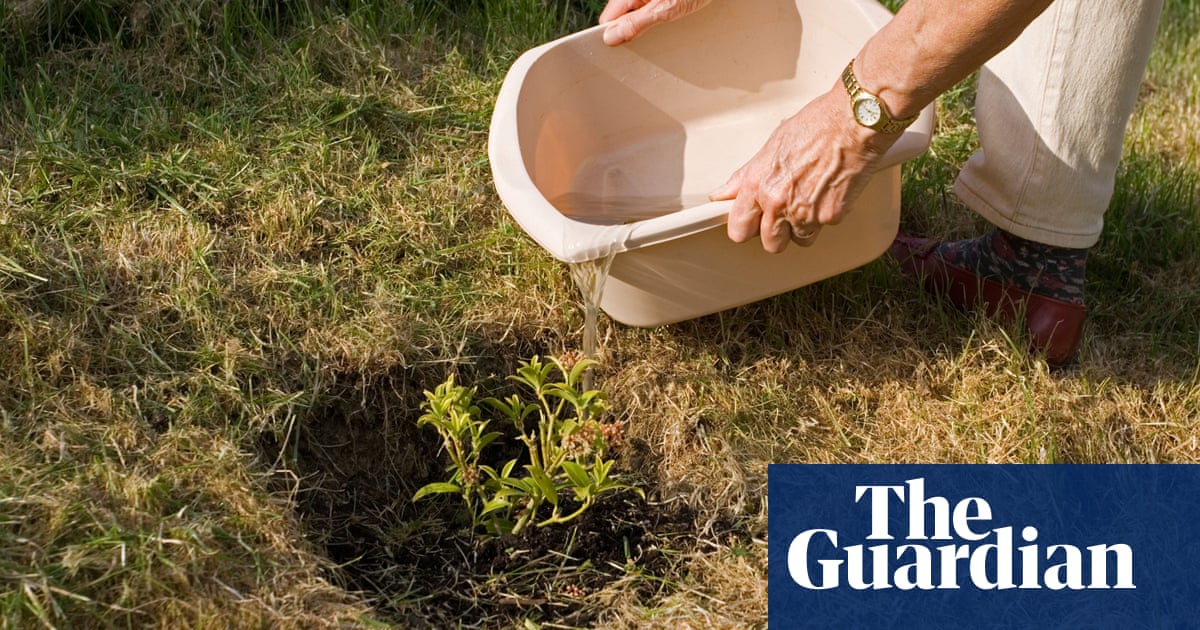Rain gardens and bathwater are becoming gardening trends, the Royal Horticultural Society has said, as gardeners battle predicted water shortages caused by climate breakdown.
At the Chelsea flower show this year, many of the gardens will be focused on reducing water usage. Rain gardens will be on show, including in the Water Aid garden, which includes a rainwater harvesting pavilion designed to slow its flow, collecting and storing it for irrigation of the garden and filtering it for use as drinking water.
Similarly, the National Autistic Society garden uses rainwater which is channelled away from the main terrace via a “waterfall roof”, which feeds into a mossy dell that acts as a swale during periods of high rainfall, holding rainwater until it can drain away into the subsoil. Rain is also channelled into areas planted with species that can cope with wet conditions.
According to the RHS, a rain garden is a shallow area of ground that receives runoff from roofs and other hard surfaces. It contains plants that can stand waterlogging for up to 48 hours at a time, with drought-tolerant specimens at the edges. The water fills the depression then drains, reducing the need for watering the garden as more moisture is held in the soil for longer. Rain gardens can absorb 30% more water than a lawn and reduce erosion by slowing heavy rainfall, as well as providing food and habitat for insects and birds.
In its own gardens, the RHS has hired experts to explore how grey water, such as from the washing up bowl and the bath, can be used safely and effectively. This includes researching plant and substrate combinations that support the right soil microbiology and plant functions to remove potential pollutants and ways to make the movement of water from house to garden more practical.
Fresh tap water is most commonly used for watering the garden, but as British people are being expected to reduce water usage by 20% by 2038 this may become less feasible. Instead, people will have to create gardens which are tolerant to drought, use water butts and start utilising grey water. One of the advantages of using grey water is that it is generated each day, so large storage tanks or reservoirs are not needed.
Dr Nicholas Cryer, senior water scientist at the RHS, said: “The greenest approach to watering your garden is to minimise its use entirely through clever planting and good soil care, with rainwater harvesting the next best thing. But with summers predicted to become hotter and drier and the need to remedy a growing water deficit, we need to be more creative in how we maintain our green spaces. Single use products are now rightly frowned upon and we should consider water the same way. The estimated 60 litres of grey water produced per person within our homes each day can be recycled in our gardens.”
The best plants for a rain garden according to the RHS
For the wet base, use herbaceous perennials such as:
Iris pseudocorus
Juncus effusus
Carex pendula
Lobelia cardinalis
Zantedeschia aethiopica
Then, around the edge, use shrubs and other perennials that tolerate wet soil as well as dry:
after newsletter promotion
Shrubs:
Sambucus nigra cultivars
Cornus sanguinea ‘Midwinter Fire’
Hydrangea ‘Annabelle’
Rosa rugosa
Perennials:
Ajuga reptans
Campanula glomerata
Crocosmia ‘Lucifer’
Geranium ‘Rozanne’
Then, around those, use some grasses that can tolerate drought
Calamagrostis brachytricha
Deschampsia cespitosa
Miscanthus sinensis cultivars



